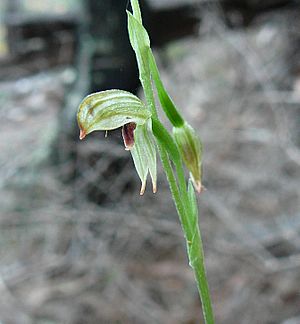Tunstall's greenhood facts for kids
Quick facts for kids Tunstall's greenhood |
|
|---|---|
 |
|
| Tunstall's greenhood | |
| Scientific classification | |
| Genus: |
Pterostylis
|
| Species: |
tunstallii
|
| Synonyms | |
|
|
Pterostylis tunstallii, also known as Tunstall's greenhood or granite greenhood, is a special type of plant in the orchid family. It grows only in south-eastern Australia. When it flowers, it can have up to ten clear green flowers. Each flower has a dark brown, insect-like part called a labellum with a blackish "head".
Plants that are not flowering have a group of leaves shaped like a circle, called a rosette, on a short stem. However, flowering plants do not have this rosette. Instead, they have five to eight leaves on their main stem.
What Tunstall's Greenhood Looks Like
Tunstall's greenhood is a plant that grows from an underground tuber (like a small potato). It is a perennial plant, meaning it lives for more than two years. It is also deciduous, so its leaves fall off at certain times of the year.
Non-flowering plants have a rosette of three to five egg-shaped leaves. These leaves are about 3 to 6 centimeters (1.2 to 2.4 inches) long and 0.4 to 0.9 centimeters (0.16 to 0.35 inches) wide. The stalk holding these leaves is about 3 to 6 centimeters (1.2 to 2.4 inches) long.
Flowering plants can grow up to ten clear green flowers on a stem that is 15 to 50 centimeters (5.9 to 19.7 inches) tall. This stem has five to eight leaves, each about 3 to 6 centimeters (1.2 to 2.4 inches) long and 0.3 to 0.5 centimeters (0.12 to 0.20 inches) wide.
The flowers themselves are about 0.7 to 1 centimeter (0.28 to 0.39 inches) long and 0.5 to 0.7 centimeters (0.20 to 0.28 inches) wide. The top part of the flower, called the dorsal sepal, and the petals are joined together. They form a hood over the column (the central part of the orchid flower). The dorsal sepal has a short point at its tip.
The side sepals point downwards and are also 0.7 to 1 centimeter (0.28 to 0.39 inches) long and 0.5 to 0.7 centimeters (0.20 to 0.28 inches) wide. They are joined for most of their length and have a narrow brown tip about 0.4 centimeters (0.16 inches) long. The labellum, which looks like an insect, is about 0.5 centimeters (0.20 inches) long and 0.2 centimeters (0.079 inches) wide. It is dark brown with a blackish "head" end. Tunstall's greenhood flowers from July to August.
Where Tunstall's Greenhood Grows
Tunstall's greenhood can be found in south-eastern Australia. It grows south from the Blue Mountains in New South Wales. You can also find it in southern Victoria, east from Wilsons Promontory, and in Tasmania, including the Bass Strait islands. This orchid prefers to grow in moist forests near the coast.

